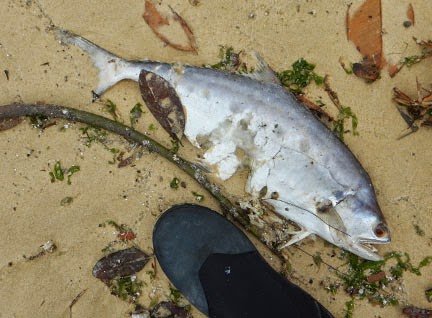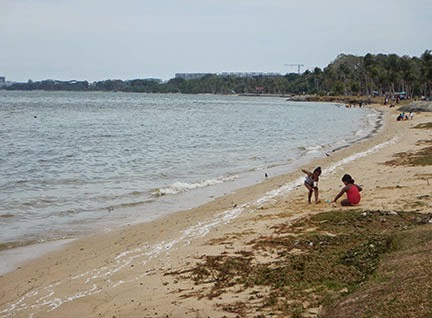I saw white powdery insoluble stuff deposited at most recent mid-tide line. Dead fishes of various kinds large and small every 20 steps or so. More below about why it is important for human health, to find out what is killing the fishes.
The white powdery insoluble stuff deposited at most recent mid-tide line.
The stuff was hard, flaky, light and insoluble (not scum). Looks a bit like hair-like flakes of wax.
The line of white powdery stuff was deposited for quite some distance along the shoreline. Children were playing nearby.
I saw dead fishes of various kinds large and small, wild and farmed, every 20 steps or so. Thanks to IDs provided by friends on my early facebook post, here's some tentative IDs.
 |
| Fish A: Barracuda, wild |
 |
| Fish B: Pompano, farmed. Thanks to Shannon Lim for the ID |
 |
| Fish C: Queenfish, wild |
 |
| Fish D: Queenfish, wild |
 |
| Fish E: Green chromide, wild |
 |
| Fish F: Orange spotted rabbitfish, wild |
 |
| Fish G (left): Stolephorus indicus and Fish H (right): Ambassis kopsii Thanks to Shannon Lim and Ivan Kwan for the IDs |
Are these farmed fishes?
 |
| Fish I: Snapper, possibly Lutjanus russelli, wild. Thanks to Shannon Lim for the ID. |
 |
| Fish J |
 |
| Fish K |
In total, I came across about 20 of these small groupers.
The shoreline was very well used on this long holiday season. There were families picnicking and camping on the water's edge. People cast-netting for fish and swimming in the water.
There were many people fishing along the shoreline. The shore didn't seem to be cleaned yet from the latest high spring tide. Perhaps the cleaners are off for the long holidays?
Some people were kayaking and kayak fishing.
There was a kind of gully on the high shore where water has collected with floating debris.
The area I surveyed was about 800m near Pasir Ris Carpark E (yellow line).
Last night, I received these photos of what is happening at the Eastern fish farms located in the waters between Pasir Ris and Pulau Ubin.
Update 23 Feb: I've been asked to take down the photos I shared earlier. Meanwhile, similar photos are already featured in a Channel 8 News article that aired on 22 Feb. Below are some screen shots.
See also AVA probing fish deaths off Pasir Ris Authority warned coastal farmers of elevated plankton levels days before die-off, Today Online 23 Feb 15
What is killing the fishes at Pasir Ris?
Around the same time last year, there were mass fish deaths at the Eastern fish farms located in the waters between Pasir Ris and Pulau Ubin. Conditions now are rather similar to last year: cloudless dry weather leading to higher water temperatures in the narrow Johor Straits. I noticed seagrass bleaching at Pasir Ris a few days ago, due to heat stress of higher water temperatures?
Higher water temperatures allow tiny organisms in the water to reproduce more rapidly. These include algae which consequently 'bloom' or rapidly increase in numbers. Like other living organisms, these absorb oxygen. The population explosion thus leads to a rapid reduction in dissolved oxygen in the water.
As populations of oxygen-sucking organisms explode, they create 'dead zones' in the water lacking oxygen. These zones kill immobile or slow-moving animals. Animals that swim into such a zone can succumb quickly and die too.
Is it important to find out exactly what are killing the fishes at Pasir Ris now?
Yes, if we care about the health of people who eat the fish raised or caught in these waters, or who use the shores.
Besides killing marine life by reducing oxygen levels, some kinds of algal blooms can be dangerous to humans too. These are often referred to as 'red tides' (although they are not always red or caused by the tide) and more properly called Harmful Algal Blooms (HAB). Such a bloom can be dangerous because the tiny algae produce toxins. Filter-feeding animals such as clams concentrate these toxins. The toxins do not harm the clams, but can be fatal to humans and other animals such as otters that eat the clams. Crabs and other marine creatures can also concentrate these toxins. The toxins are not destroyed by cooking.
People should also be advised to avoid going to the areas affected by Harmful Algal Blooms (HAB). For some kinds of toxins produced by such a Bloom, anecdotal evidence suggests that people who swim or inhale such toxins dispersed in the air may experience irritation of the eyes, nose, and throat, as well as coughing, wheezing, and shortness of breath. Additional evidence suggests that people with existing respiratory illness, such as asthma, may experience these symptoms more severely. I have been told by scientists that the symptoms are similar to those of the flu so many people may not realise they are suffering from exposure to Harmful Algal Blooms (HAB). More about red tides here.
Are the recent fish deaths an early indications of a Harmful Algal Bloom (HAB)? If there is a Harmful Algal Bloom at Pasir Ris then fishes and marine life raised in these waters should not be sold to the public, and there should be public alerts to warn everyone not to eat fishes or marine life raised or caught in the waters.
More about what likely caused last year's mass fish deaths which includes some suggestions already made last year about avoiding a similar situation from recurring.
Mass fish deaths also occurred at the Western fish farms located near Sungei Buloh and Lim Chu Kang in October last year.
Dead Fish Alert!
Please help me monitor dead fishes washing up on the Johor Straits. Please let me know if you see large numbers (more than 10) especially of large dead fishes (more than 20cm long) washing up on the northern shores such as Pulau Ubin, Lim Chu Kang, Sungei Buloh, Kranji, Sembawang, Punggol, Pasir Ris, Changi.
Thank you!
Past incidents of mass fish farm deaths on our shores
Eastern fish farms mass fish deaths
- Recent mass fish deaths: cause and implications
- Your help needed! Take photos of disposal tank at Changi for dead fishes
- What will AVA do about fish farms dumping dead fishes in the sea?Yes, dead fishes are from fish farms
- Fish farms dumping dead fishes?
- Update on the mass fish deaths at Pasir Ris and Pulau Ubin
- 'Dead fish zone' hits Pulau Ubin
- Why are there so many dead fish on Pasir Ris?
- A closer look at dead fish found on Pasir Ris
- Dead fish at Pasir Ris
Western fish farm mass fish deaths
- Lots of dead farmed fishes at Lim Chu Kang, and now also at Kranji
- Lots of dead farm fishes washed up at Lim Chu Kang and Sungei Buloh
- What is AVA doing about dead farm fishes being dumped into the water?
- Dead fish checks: Lim Chu Kang and Sungei Buloh
- Any dead fishes on Singapore's northern shores?
- What the fish? Figuring out dead fishes at Sungei Buloh
- Still lots of dead fishes at Sungei Buloh
- Thousands of farm fishes rot at Sungei Buloh
- Yes, dead fishes are from fish farms
- Fish farms dumping dead fishes?















